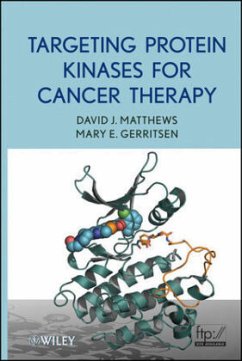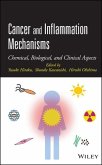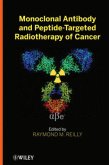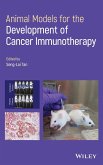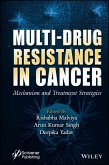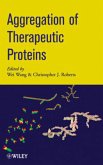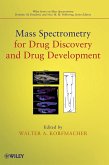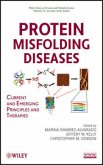- Gebundenes Buch
- Merkliste
- Auf die Merkliste
- Bewerten Bewerten
- Teilen
- Produkt teilen
- Produkterinnerung
- Produkterinnerung
This book provides an overview of different protein kinases - structure, function, regulation, and their role in cancer. It combines kinase biology with chemistry and pharmacology applications for discovery and development of cancer drugs. The text also describes existing and emerging kinase inhibitors, focusing mostly on small molecules but also alternative approaches like therapeutic antibodies. Provides an important resource that helps pharmaceutical researchers understand and work in this dynamic area of cancer drug research.
Andere Kunden interessierten sich auch für
![Cancer and Inflammation Mechanisms Cancer and Inflammation Mechanisms]() Cancer and Inflammation Mechanisms159,99 €
Cancer and Inflammation Mechanisms159,99 €![Monoclonal Antibody and Peptide-Targeted Radiotherapy of Cancer Monoclonal Antibody and Peptide-Targeted Radiotherapy of Cancer]() Monoclonal Antibody and Peptide-Targeted Radiotherapy of Cancer223,99 €
Monoclonal Antibody and Peptide-Targeted Radiotherapy of Cancer223,99 €![Animal Models for the Development of Cancer Immunotherapy Animal Models for the Development of Cancer Immunotherapy]() Animal Models for the Development of Cancer Immunotherapy186,99 €
Animal Models for the Development of Cancer Immunotherapy186,99 €![Multi-Drug Resistance in Cancer Multi-Drug Resistance in Cancer]() Multi-Drug Resistance in Cancer201,50 €
Multi-Drug Resistance in Cancer201,50 €![Aggregation of Therapeutic Proteins Aggregation of Therapeutic Proteins]() Aggregation of Therapeutic Proteins186,99 €
Aggregation of Therapeutic Proteins186,99 €![Mass Spectrometry for Drug Discovery and Drug Development Mass Spectrometry for Drug Discovery and Drug Development]() Mass Spectrometry for Drug Discovery and Drug Development158,99 €
Mass Spectrometry for Drug Discovery and Drug Development158,99 €![Protein Misfolding Diseases Protein Misfolding Diseases]() Jeffery W. KellyProtein Misfolding Diseases285,99 €
Jeffery W. KellyProtein Misfolding Diseases285,99 €-
-
-
This book provides an overview of different protein kinases - structure, function, regulation, and their role in cancer. It combines kinase biology with chemistry and pharmacology applications for discovery and development of cancer drugs. The text also describes existing and emerging kinase inhibitors, focusing mostly on small molecules but also alternative approaches like therapeutic antibodies. Provides an important resource that helps pharmaceutical researchers understand and work in this dynamic area of cancer drug research.
Hinweis: Dieser Artikel kann nur an eine deutsche Lieferadresse ausgeliefert werden.
Hinweis: Dieser Artikel kann nur an eine deutsche Lieferadresse ausgeliefert werden.
Produktdetails
- Produktdetails
- Verlag: Wiley & Sons
- 1. Auflage
- Seitenzahl: 720
- Erscheinungstermin: 1. Februar 2010
- Englisch
- Abmessung: 243mm x 164mm x 45mm
- Gewicht: 1105g
- ISBN-13: 9780470229651
- ISBN-10: 0470229659
- Artikelnr.: 27871072
- Herstellerkennzeichnung
- Libri GmbH
- Europaallee 1
- 36244 Bad Hersfeld
- gpsr@libri.de
- Verlag: Wiley & Sons
- 1. Auflage
- Seitenzahl: 720
- Erscheinungstermin: 1. Februar 2010
- Englisch
- Abmessung: 243mm x 164mm x 45mm
- Gewicht: 1105g
- ISBN-13: 9780470229651
- ISBN-10: 0470229659
- Artikelnr.: 27871072
- Herstellerkennzeichnung
- Libri GmbH
- Europaallee 1
- 36244 Bad Hersfeld
- gpsr@libri.de
DAVID J. MATTHEWS is Executive Director of Oncology Discovery at Exelixis, where he is responsible for cancer drug discovery. For more than fifteen years, Dr. Matthews has been involved in drug discovery projects in industry, with particular focus on small molecule inhibitors. He has twenty scientific publications and multiple patents to his credit. MARY E. GERRITSEN is Vice President of Molecular and Cellular Pharmacology at Exelixis, where she is in charge of cell-based screening in preclinical research and of biomarker studies for clinical development compounds in Phase I and II studies. Her prior industry experience includes positions at Genentech, Bayer and Millennium Pharmaceuticals. She has authored more than one hundred peer-reviewed articles and twenty-six book chapters and is an inventor on forty-two issued patents.
Preface.
Acknowledgments.
1 KINASES AND CANCER.
1.1 A Brief History of Protein Phosphorylation.
1.2 Kinases and Cancer.
1.3 A Tour of the Human Protein Kinase Superfamily.
1.3.1 Tyrosine Kinase Group.
1.3.2 TKL (Tyrosine Kinase-Like) Group.
1.3.3 STE Group.
1.3.4 CSNK1 Group.
1.3.5 AGC group.
1.3.6 CAMK Group.
1.3.7 CMGC Group.
1.3.8 RGC Group.
1.3.9 Others.
1.3.10 Atypical Protein Kinases.
1.3.11 Non-Protein Kinases.
1.4 Strategic Considerations for Selecting Kinases as Drug Targets.
1.5 Comparison of Kinase Inhibitor Therapeutic Strategies.
1.5.1 Small Molecule Versus Antibody-Directed Therapies.
1.5.2 Alternative Strategies for Kinase Inhibition.
References.
2 PROTEIN KINASE STRUCTURE, FUNCTION AND REGULATION.
2.1 Ligand Binding to Receptor Tyrosine Kinases.
2.1.1 EGF:EGF Receptor Interactions.
2.1.2 Insulin:Insulin Receptor and IGF1:IGF1R.
2.1.3 FGF:FGF Receptor (Heparin/Heparan Sulphate) Interactions.
2.1.4 VEGF:VEGF Receptor Interactions.
2.1.5 Angiopoietin2:TIE2 Receptor Interactions.
2.1.6 Ephrin:EPH Receptor Interactions.
2.1.7 The Role of Transmembrane Domains.
2.2 Protein Kinase Domain Structure and Function.
2.3 Catalytic Activity of Protein Kinases.
2.3.1 Steady State Kinetics.
2.3.2 Chemistry of Protein Kinase Catalysis.
2.4 Protein Kinase Regulation.
2.4.1 Regulation Via Activation Segment Phosphorylation.
2.4.2 Regulation by N-terminal Sequences and Domains.
2.4.3 C-Terminal Regulatory Regions.
2.4.4 Regulation by Other Domains and Partner Proteins.
References.
3 RECPETOR TYROSINE KINASES.
3.1 EGF/ERBB Receptors.
3.1.1 ERBB Receptors and Cancer.
3.2 Insulin/IGF Receptors.
3.2.1 Insulin/IGF Receptors and Cancer.
3.3 Anaplastic Lymphoma Kinase.
3.3.1 ALK and Cancer.
3.4 VEGF Receptors (VEGFR1, VEGFR2, VEGFR3).
3.5 PDGF Receptors.
3.5.1 PDGFRs and Cancer.
3.6 FGF Receptors.
3.6.1 FGFRs and Cancer.
3.7 KIT.
3.7.1 KIT and Cancer.
3.8 FLT3.
3.8.1 FLT3 and Cancer.
3.9 RET.
3.9.1 RET and Thyroid Carcinoma.
3.10 MET and RON.
3.10.1 MET.
3.10.2 RON.
References.
4 NONRECEPTOR TYROSINE KINASES.
4.1 ABL.
4.2 ARG.
4.3 SRC and SRC Family Kinases.
4.3.1 SRC.
4.3.2 Cellular Roles of SRC.
4.3.3 SRC and Cancer.
4.4 FAK.
4.4.1 FAK and Cancer.
4.5 JAK2.
4.5.1 Activation and Known Mutations and Fusions of the JAK Family of
Tyrosine Kinases.
4.5.2 Further Roles of JAK2 in Tumor Growth.
References.
5 INTRACELLULAR SIGNAL TRANSDUCTION CASCADES.
5.1 The PI3K/PTEN Pathway.
5.1.1 PI3K.
5.1.2 PDK1.
5.1.3 AKT.
5.1.4 Other AGC Kinases.
5.1.5 PI3K Pathway Activation in Cancer.
5.2 mTOR Signaling.
5.2.1 mTOR.
5.2.2 p70S6 Kinase.
5.2.3 mTOR Pathway Activation in Cancer.
5.3 MAPK Signaling Pathways.
5.3.1 ERK/MAPK Signaling.
5.3.2 RAF Family Kinases.
5.3.3 MEK and ERK Kinases.
5.3.4 ERK/MAPK Pathway Activation in Cancer.
5.4 PIM Kinases.
5.5 Protein Kinase C.
5.5.1 PKC Activation.
5.5.2 Classical PKCs.
5.5.3 Novel PKCs.
5.5.4 Atypical PKCs.
References.
6 CELL CYCLE CONTROL.
6.1 Cyclin-Dependent Kinases (CDKs) and Cell Cycle Progression.
6.1.1 Introduction.
6.1.2 CDK4 and CDK6.
6.1.3 CDK2.
6.1.4 CDK3.
6.1.5 CDK1.
6.1.6 CDK10.
6.1.7 CCRK/CDCH/p42.
6.2 CDKs and mRNA Production.
6.2.1 Introduction.
6.2.2 CDK7.
6.2.3 CDK8.
6.2.4 CDK9.
6.2.5 CDK11.
6.2.6 CDK12 (CDC2-Related Kinase CRKRS).
6.2.7 CDK13 (CDC2L5).
6.3 Other CDK-Related Kinases.
6.3.1 CDK5.
6.3.2 GAK.
6.4 Mitotic Kinases.
6.4.1 PLKs.
6.4.2 Aurora Kinases.
6.5 Cell Cycle Checkpoint Kinases.
6.5.1 ATM, ATR and DNAPK.
6.5.2 CHK1, CHK2 and MAPKAPK2.
References.
7 STRUCTURAL BIOCHEMSITRY OF KINASE INHIBITORS.
7.1 Strategies for Inhibitor Design.
7.1.1 Targeting the Active Versus Inactive Form.
7.1.2 ATP-Competitive Versus Noncompetitive Inhibitors.
7.1.3 Specific Versus Multitargeted Inhibitors.
7.2 Architecture of the ATP Binding Site: DFG-in.
7.3 Case Study: Inhibitors of CHK1.
7.4 Case Study: Inhibitors of CDK2.
7.5 Case Study: Inhibitors of SRC Family Kinases.
7.6 Case Study: EGF Receptor Inhibitors.
7.7 Targeting the Inactive Conformation.
7.7.1 Binding Mode of Imatinib.
7.7.2 Binding of BAY-43-9006 (Sorafenib) to the Inactive BRAF Kinase.
7.8 Noncompetitive Inhibition.
7.9 Kinase Inhibitor Specificity.
References.
8 TYROSINE KINASE INHIBITORS.
8.1 BCR-ABL Inhibitors.
8.2 SRC Inhibitors.
8.3 JAK2 Inhibitors.
8.4 EGFR/ERBB Inhibitors.
8.4.1 Determinants of Response and Resistance to ERBB Inhibitors.
8.5 IGF1R Inhibitors.
8.6 FLT3 Inhibitors.
8.7 KIT Inhibitors.
8.8 MET/RON Inhibitors.
8.9 RET Inhibitors.
8.10 Other Inhibitors.
8.10.1 FAK.
8.10.2 TGFß Receptor.
References.
9 ANGIOKINASE INHIBITORS.
9.1 Introduction.
9.2 Angiokinase Inhibitors.
References.
10 INTRACELLULAR SIGNALING KINASE INHIBITORS.
10.1 mTOR Inhibitors.
10.1.1 Clinical Pharmacodynamics and Tolerability of mTOR Inhibitors.
10.2 PI3K Inhibitors.
10.3 RAF Kinase Inhibitors.
10.4 MEK Inhibitors.
10.5 CDK Inhibitors.
10.6 Cell Cycle Checkpoint Kinase Inhibitors.
10.7 Mitotic Kinase Inhibitors.
10.7.1 PLK Inhibitors.
10.7.2 Aurora Kinase Inhibitors.
10.8 Protein Kinase C Inhibitors.
References.
11 CURRENT CHALLENGES AND FUTURE DIRECTIONS.
11.1 Kinase Inhibitor Drug Resistance.
11.1.1 Efflux Pumps and Drug Transporters.
11.1.2 Other DMPK factors.
11.1.3 Target Mutation.
11.1.4 Target Overexpression and Activation.
11.1.5 Downstream Pathway Activation.
11.1.6 Redundant Receptors/Pathways.
11.2 Combination Therapy With Kinase Inhibitors.
11.2.1 Angiogenesis Inhibitors and Chemotherapy.
11.2.2 Survival Pathway Inhibitors and Chemotherapy/Targeted Therapy.
11.2.3 DNA Damage Checkpoint Inhibitors and Chemotherapy.
11.2.4 RTK Switching: Targeting Receptor Redundancy.
11.3 Systems Biology and Translational Medicine.
11.3.1 Classification of Tumors and Prediction of Response: Expression
Profiling.
11.3.2 Phosphoprotein Analysis, Kinomics and Systems-Based Approaches.
11.3.3 Translational Medicine.
11.4 Conclusions.
References.
List of Abbreviations.
Index.
Acknowledgments.
1 KINASES AND CANCER.
1.1 A Brief History of Protein Phosphorylation.
1.2 Kinases and Cancer.
1.3 A Tour of the Human Protein Kinase Superfamily.
1.3.1 Tyrosine Kinase Group.
1.3.2 TKL (Tyrosine Kinase-Like) Group.
1.3.3 STE Group.
1.3.4 CSNK1 Group.
1.3.5 AGC group.
1.3.6 CAMK Group.
1.3.7 CMGC Group.
1.3.8 RGC Group.
1.3.9 Others.
1.3.10 Atypical Protein Kinases.
1.3.11 Non-Protein Kinases.
1.4 Strategic Considerations for Selecting Kinases as Drug Targets.
1.5 Comparison of Kinase Inhibitor Therapeutic Strategies.
1.5.1 Small Molecule Versus Antibody-Directed Therapies.
1.5.2 Alternative Strategies for Kinase Inhibition.
References.
2 PROTEIN KINASE STRUCTURE, FUNCTION AND REGULATION.
2.1 Ligand Binding to Receptor Tyrosine Kinases.
2.1.1 EGF:EGF Receptor Interactions.
2.1.2 Insulin:Insulin Receptor and IGF1:IGF1R.
2.1.3 FGF:FGF Receptor (Heparin/Heparan Sulphate) Interactions.
2.1.4 VEGF:VEGF Receptor Interactions.
2.1.5 Angiopoietin2:TIE2 Receptor Interactions.
2.1.6 Ephrin:EPH Receptor Interactions.
2.1.7 The Role of Transmembrane Domains.
2.2 Protein Kinase Domain Structure and Function.
2.3 Catalytic Activity of Protein Kinases.
2.3.1 Steady State Kinetics.
2.3.2 Chemistry of Protein Kinase Catalysis.
2.4 Protein Kinase Regulation.
2.4.1 Regulation Via Activation Segment Phosphorylation.
2.4.2 Regulation by N-terminal Sequences and Domains.
2.4.3 C-Terminal Regulatory Regions.
2.4.4 Regulation by Other Domains and Partner Proteins.
References.
3 RECPETOR TYROSINE KINASES.
3.1 EGF/ERBB Receptors.
3.1.1 ERBB Receptors and Cancer.
3.2 Insulin/IGF Receptors.
3.2.1 Insulin/IGF Receptors and Cancer.
3.3 Anaplastic Lymphoma Kinase.
3.3.1 ALK and Cancer.
3.4 VEGF Receptors (VEGFR1, VEGFR2, VEGFR3).
3.5 PDGF Receptors.
3.5.1 PDGFRs and Cancer.
3.6 FGF Receptors.
3.6.1 FGFRs and Cancer.
3.7 KIT.
3.7.1 KIT and Cancer.
3.8 FLT3.
3.8.1 FLT3 and Cancer.
3.9 RET.
3.9.1 RET and Thyroid Carcinoma.
3.10 MET and RON.
3.10.1 MET.
3.10.2 RON.
References.
4 NONRECEPTOR TYROSINE KINASES.
4.1 ABL.
4.2 ARG.
4.3 SRC and SRC Family Kinases.
4.3.1 SRC.
4.3.2 Cellular Roles of SRC.
4.3.3 SRC and Cancer.
4.4 FAK.
4.4.1 FAK and Cancer.
4.5 JAK2.
4.5.1 Activation and Known Mutations and Fusions of the JAK Family of
Tyrosine Kinases.
4.5.2 Further Roles of JAK2 in Tumor Growth.
References.
5 INTRACELLULAR SIGNAL TRANSDUCTION CASCADES.
5.1 The PI3K/PTEN Pathway.
5.1.1 PI3K.
5.1.2 PDK1.
5.1.3 AKT.
5.1.4 Other AGC Kinases.
5.1.5 PI3K Pathway Activation in Cancer.
5.2 mTOR Signaling.
5.2.1 mTOR.
5.2.2 p70S6 Kinase.
5.2.3 mTOR Pathway Activation in Cancer.
5.3 MAPK Signaling Pathways.
5.3.1 ERK/MAPK Signaling.
5.3.2 RAF Family Kinases.
5.3.3 MEK and ERK Kinases.
5.3.4 ERK/MAPK Pathway Activation in Cancer.
5.4 PIM Kinases.
5.5 Protein Kinase C.
5.5.1 PKC Activation.
5.5.2 Classical PKCs.
5.5.3 Novel PKCs.
5.5.4 Atypical PKCs.
References.
6 CELL CYCLE CONTROL.
6.1 Cyclin-Dependent Kinases (CDKs) and Cell Cycle Progression.
6.1.1 Introduction.
6.1.2 CDK4 and CDK6.
6.1.3 CDK2.
6.1.4 CDK3.
6.1.5 CDK1.
6.1.6 CDK10.
6.1.7 CCRK/CDCH/p42.
6.2 CDKs and mRNA Production.
6.2.1 Introduction.
6.2.2 CDK7.
6.2.3 CDK8.
6.2.4 CDK9.
6.2.5 CDK11.
6.2.6 CDK12 (CDC2-Related Kinase CRKRS).
6.2.7 CDK13 (CDC2L5).
6.3 Other CDK-Related Kinases.
6.3.1 CDK5.
6.3.2 GAK.
6.4 Mitotic Kinases.
6.4.1 PLKs.
6.4.2 Aurora Kinases.
6.5 Cell Cycle Checkpoint Kinases.
6.5.1 ATM, ATR and DNAPK.
6.5.2 CHK1, CHK2 and MAPKAPK2.
References.
7 STRUCTURAL BIOCHEMSITRY OF KINASE INHIBITORS.
7.1 Strategies for Inhibitor Design.
7.1.1 Targeting the Active Versus Inactive Form.
7.1.2 ATP-Competitive Versus Noncompetitive Inhibitors.
7.1.3 Specific Versus Multitargeted Inhibitors.
7.2 Architecture of the ATP Binding Site: DFG-in.
7.3 Case Study: Inhibitors of CHK1.
7.4 Case Study: Inhibitors of CDK2.
7.5 Case Study: Inhibitors of SRC Family Kinases.
7.6 Case Study: EGF Receptor Inhibitors.
7.7 Targeting the Inactive Conformation.
7.7.1 Binding Mode of Imatinib.
7.7.2 Binding of BAY-43-9006 (Sorafenib) to the Inactive BRAF Kinase.
7.8 Noncompetitive Inhibition.
7.9 Kinase Inhibitor Specificity.
References.
8 TYROSINE KINASE INHIBITORS.
8.1 BCR-ABL Inhibitors.
8.2 SRC Inhibitors.
8.3 JAK2 Inhibitors.
8.4 EGFR/ERBB Inhibitors.
8.4.1 Determinants of Response and Resistance to ERBB Inhibitors.
8.5 IGF1R Inhibitors.
8.6 FLT3 Inhibitors.
8.7 KIT Inhibitors.
8.8 MET/RON Inhibitors.
8.9 RET Inhibitors.
8.10 Other Inhibitors.
8.10.1 FAK.
8.10.2 TGFß Receptor.
References.
9 ANGIOKINASE INHIBITORS.
9.1 Introduction.
9.2 Angiokinase Inhibitors.
References.
10 INTRACELLULAR SIGNALING KINASE INHIBITORS.
10.1 mTOR Inhibitors.
10.1.1 Clinical Pharmacodynamics and Tolerability of mTOR Inhibitors.
10.2 PI3K Inhibitors.
10.3 RAF Kinase Inhibitors.
10.4 MEK Inhibitors.
10.5 CDK Inhibitors.
10.6 Cell Cycle Checkpoint Kinase Inhibitors.
10.7 Mitotic Kinase Inhibitors.
10.7.1 PLK Inhibitors.
10.7.2 Aurora Kinase Inhibitors.
10.8 Protein Kinase C Inhibitors.
References.
11 CURRENT CHALLENGES AND FUTURE DIRECTIONS.
11.1 Kinase Inhibitor Drug Resistance.
11.1.1 Efflux Pumps and Drug Transporters.
11.1.2 Other DMPK factors.
11.1.3 Target Mutation.
11.1.4 Target Overexpression and Activation.
11.1.5 Downstream Pathway Activation.
11.1.6 Redundant Receptors/Pathways.
11.2 Combination Therapy With Kinase Inhibitors.
11.2.1 Angiogenesis Inhibitors and Chemotherapy.
11.2.2 Survival Pathway Inhibitors and Chemotherapy/Targeted Therapy.
11.2.3 DNA Damage Checkpoint Inhibitors and Chemotherapy.
11.2.4 RTK Switching: Targeting Receptor Redundancy.
11.3 Systems Biology and Translational Medicine.
11.3.1 Classification of Tumors and Prediction of Response: Expression
Profiling.
11.3.2 Phosphoprotein Analysis, Kinomics and Systems-Based Approaches.
11.3.3 Translational Medicine.
11.4 Conclusions.
References.
List of Abbreviations.
Index.
Preface.
Acknowledgments.
1 KINASES AND CANCER.
1.1 A Brief History of Protein Phosphorylation.
1.2 Kinases and Cancer.
1.3 A Tour of the Human Protein Kinase Superfamily.
1.3.1 Tyrosine Kinase Group.
1.3.2 TKL (Tyrosine Kinase-Like) Group.
1.3.3 STE Group.
1.3.4 CSNK1 Group.
1.3.5 AGC group.
1.3.6 CAMK Group.
1.3.7 CMGC Group.
1.3.8 RGC Group.
1.3.9 Others.
1.3.10 Atypical Protein Kinases.
1.3.11 Non-Protein Kinases.
1.4 Strategic Considerations for Selecting Kinases as Drug Targets.
1.5 Comparison of Kinase Inhibitor Therapeutic Strategies.
1.5.1 Small Molecule Versus Antibody-Directed Therapies.
1.5.2 Alternative Strategies for Kinase Inhibition.
References.
2 PROTEIN KINASE STRUCTURE, FUNCTION AND REGULATION.
2.1 Ligand Binding to Receptor Tyrosine Kinases.
2.1.1 EGF:EGF Receptor Interactions.
2.1.2 Insulin:Insulin Receptor and IGF1:IGF1R.
2.1.3 FGF:FGF Receptor (Heparin/Heparan Sulphate) Interactions.
2.1.4 VEGF:VEGF Receptor Interactions.
2.1.5 Angiopoietin2:TIE2 Receptor Interactions.
2.1.6 Ephrin:EPH Receptor Interactions.
2.1.7 The Role of Transmembrane Domains.
2.2 Protein Kinase Domain Structure and Function.
2.3 Catalytic Activity of Protein Kinases.
2.3.1 Steady State Kinetics.
2.3.2 Chemistry of Protein Kinase Catalysis.
2.4 Protein Kinase Regulation.
2.4.1 Regulation Via Activation Segment Phosphorylation.
2.4.2 Regulation by N-terminal Sequences and Domains.
2.4.3 C-Terminal Regulatory Regions.
2.4.4 Regulation by Other Domains and Partner Proteins.
References.
3 RECPETOR TYROSINE KINASES.
3.1 EGF/ERBB Receptors.
3.1.1 ERBB Receptors and Cancer.
3.2 Insulin/IGF Receptors.
3.2.1 Insulin/IGF Receptors and Cancer.
3.3 Anaplastic Lymphoma Kinase.
3.3.1 ALK and Cancer.
3.4 VEGF Receptors (VEGFR1, VEGFR2, VEGFR3).
3.5 PDGF Receptors.
3.5.1 PDGFRs and Cancer.
3.6 FGF Receptors.
3.6.1 FGFRs and Cancer.
3.7 KIT.
3.7.1 KIT and Cancer.
3.8 FLT3.
3.8.1 FLT3 and Cancer.
3.9 RET.
3.9.1 RET and Thyroid Carcinoma.
3.10 MET and RON.
3.10.1 MET.
3.10.2 RON.
References.
4 NONRECEPTOR TYROSINE KINASES.
4.1 ABL.
4.2 ARG.
4.3 SRC and SRC Family Kinases.
4.3.1 SRC.
4.3.2 Cellular Roles of SRC.
4.3.3 SRC and Cancer.
4.4 FAK.
4.4.1 FAK and Cancer.
4.5 JAK2.
4.5.1 Activation and Known Mutations and Fusions of the JAK Family of
Tyrosine Kinases.
4.5.2 Further Roles of JAK2 in Tumor Growth.
References.
5 INTRACELLULAR SIGNAL TRANSDUCTION CASCADES.
5.1 The PI3K/PTEN Pathway.
5.1.1 PI3K.
5.1.2 PDK1.
5.1.3 AKT.
5.1.4 Other AGC Kinases.
5.1.5 PI3K Pathway Activation in Cancer.
5.2 mTOR Signaling.
5.2.1 mTOR.
5.2.2 p70S6 Kinase.
5.2.3 mTOR Pathway Activation in Cancer.
5.3 MAPK Signaling Pathways.
5.3.1 ERK/MAPK Signaling.
5.3.2 RAF Family Kinases.
5.3.3 MEK and ERK Kinases.
5.3.4 ERK/MAPK Pathway Activation in Cancer.
5.4 PIM Kinases.
5.5 Protein Kinase C.
5.5.1 PKC Activation.
5.5.2 Classical PKCs.
5.5.3 Novel PKCs.
5.5.4 Atypical PKCs.
References.
6 CELL CYCLE CONTROL.
6.1 Cyclin-Dependent Kinases (CDKs) and Cell Cycle Progression.
6.1.1 Introduction.
6.1.2 CDK4 and CDK6.
6.1.3 CDK2.
6.1.4 CDK3.
6.1.5 CDK1.
6.1.6 CDK10.
6.1.7 CCRK/CDCH/p42.
6.2 CDKs and mRNA Production.
6.2.1 Introduction.
6.2.2 CDK7.
6.2.3 CDK8.
6.2.4 CDK9.
6.2.5 CDK11.
6.2.6 CDK12 (CDC2-Related Kinase CRKRS).
6.2.7 CDK13 (CDC2L5).
6.3 Other CDK-Related Kinases.
6.3.1 CDK5.
6.3.2 GAK.
6.4 Mitotic Kinases.
6.4.1 PLKs.
6.4.2 Aurora Kinases.
6.5 Cell Cycle Checkpoint Kinases.
6.5.1 ATM, ATR and DNAPK.
6.5.2 CHK1, CHK2 and MAPKAPK2.
References.
7 STRUCTURAL BIOCHEMSITRY OF KINASE INHIBITORS.
7.1 Strategies for Inhibitor Design.
7.1.1 Targeting the Active Versus Inactive Form.
7.1.2 ATP-Competitive Versus Noncompetitive Inhibitors.
7.1.3 Specific Versus Multitargeted Inhibitors.
7.2 Architecture of the ATP Binding Site: DFG-in.
7.3 Case Study: Inhibitors of CHK1.
7.4 Case Study: Inhibitors of CDK2.
7.5 Case Study: Inhibitors of SRC Family Kinases.
7.6 Case Study: EGF Receptor Inhibitors.
7.7 Targeting the Inactive Conformation.
7.7.1 Binding Mode of Imatinib.
7.7.2 Binding of BAY-43-9006 (Sorafenib) to the Inactive BRAF Kinase.
7.8 Noncompetitive Inhibition.
7.9 Kinase Inhibitor Specificity.
References.
8 TYROSINE KINASE INHIBITORS.
8.1 BCR-ABL Inhibitors.
8.2 SRC Inhibitors.
8.3 JAK2 Inhibitors.
8.4 EGFR/ERBB Inhibitors.
8.4.1 Determinants of Response and Resistance to ERBB Inhibitors.
8.5 IGF1R Inhibitors.
8.6 FLT3 Inhibitors.
8.7 KIT Inhibitors.
8.8 MET/RON Inhibitors.
8.9 RET Inhibitors.
8.10 Other Inhibitors.
8.10.1 FAK.
8.10.2 TGFß Receptor.
References.
9 ANGIOKINASE INHIBITORS.
9.1 Introduction.
9.2 Angiokinase Inhibitors.
References.
10 INTRACELLULAR SIGNALING KINASE INHIBITORS.
10.1 mTOR Inhibitors.
10.1.1 Clinical Pharmacodynamics and Tolerability of mTOR Inhibitors.
10.2 PI3K Inhibitors.
10.3 RAF Kinase Inhibitors.
10.4 MEK Inhibitors.
10.5 CDK Inhibitors.
10.6 Cell Cycle Checkpoint Kinase Inhibitors.
10.7 Mitotic Kinase Inhibitors.
10.7.1 PLK Inhibitors.
10.7.2 Aurora Kinase Inhibitors.
10.8 Protein Kinase C Inhibitors.
References.
11 CURRENT CHALLENGES AND FUTURE DIRECTIONS.
11.1 Kinase Inhibitor Drug Resistance.
11.1.1 Efflux Pumps and Drug Transporters.
11.1.2 Other DMPK factors.
11.1.3 Target Mutation.
11.1.4 Target Overexpression and Activation.
11.1.5 Downstream Pathway Activation.
11.1.6 Redundant Receptors/Pathways.
11.2 Combination Therapy With Kinase Inhibitors.
11.2.1 Angiogenesis Inhibitors and Chemotherapy.
11.2.2 Survival Pathway Inhibitors and Chemotherapy/Targeted Therapy.
11.2.3 DNA Damage Checkpoint Inhibitors and Chemotherapy.
11.2.4 RTK Switching: Targeting Receptor Redundancy.
11.3 Systems Biology and Translational Medicine.
11.3.1 Classification of Tumors and Prediction of Response: Expression
Profiling.
11.3.2 Phosphoprotein Analysis, Kinomics and Systems-Based Approaches.
11.3.3 Translational Medicine.
11.4 Conclusions.
References.
List of Abbreviations.
Index.
Acknowledgments.
1 KINASES AND CANCER.
1.1 A Brief History of Protein Phosphorylation.
1.2 Kinases and Cancer.
1.3 A Tour of the Human Protein Kinase Superfamily.
1.3.1 Tyrosine Kinase Group.
1.3.2 TKL (Tyrosine Kinase-Like) Group.
1.3.3 STE Group.
1.3.4 CSNK1 Group.
1.3.5 AGC group.
1.3.6 CAMK Group.
1.3.7 CMGC Group.
1.3.8 RGC Group.
1.3.9 Others.
1.3.10 Atypical Protein Kinases.
1.3.11 Non-Protein Kinases.
1.4 Strategic Considerations for Selecting Kinases as Drug Targets.
1.5 Comparison of Kinase Inhibitor Therapeutic Strategies.
1.5.1 Small Molecule Versus Antibody-Directed Therapies.
1.5.2 Alternative Strategies for Kinase Inhibition.
References.
2 PROTEIN KINASE STRUCTURE, FUNCTION AND REGULATION.
2.1 Ligand Binding to Receptor Tyrosine Kinases.
2.1.1 EGF:EGF Receptor Interactions.
2.1.2 Insulin:Insulin Receptor and IGF1:IGF1R.
2.1.3 FGF:FGF Receptor (Heparin/Heparan Sulphate) Interactions.
2.1.4 VEGF:VEGF Receptor Interactions.
2.1.5 Angiopoietin2:TIE2 Receptor Interactions.
2.1.6 Ephrin:EPH Receptor Interactions.
2.1.7 The Role of Transmembrane Domains.
2.2 Protein Kinase Domain Structure and Function.
2.3 Catalytic Activity of Protein Kinases.
2.3.1 Steady State Kinetics.
2.3.2 Chemistry of Protein Kinase Catalysis.
2.4 Protein Kinase Regulation.
2.4.1 Regulation Via Activation Segment Phosphorylation.
2.4.2 Regulation by N-terminal Sequences and Domains.
2.4.3 C-Terminal Regulatory Regions.
2.4.4 Regulation by Other Domains and Partner Proteins.
References.
3 RECPETOR TYROSINE KINASES.
3.1 EGF/ERBB Receptors.
3.1.1 ERBB Receptors and Cancer.
3.2 Insulin/IGF Receptors.
3.2.1 Insulin/IGF Receptors and Cancer.
3.3 Anaplastic Lymphoma Kinase.
3.3.1 ALK and Cancer.
3.4 VEGF Receptors (VEGFR1, VEGFR2, VEGFR3).
3.5 PDGF Receptors.
3.5.1 PDGFRs and Cancer.
3.6 FGF Receptors.
3.6.1 FGFRs and Cancer.
3.7 KIT.
3.7.1 KIT and Cancer.
3.8 FLT3.
3.8.1 FLT3 and Cancer.
3.9 RET.
3.9.1 RET and Thyroid Carcinoma.
3.10 MET and RON.
3.10.1 MET.
3.10.2 RON.
References.
4 NONRECEPTOR TYROSINE KINASES.
4.1 ABL.
4.2 ARG.
4.3 SRC and SRC Family Kinases.
4.3.1 SRC.
4.3.2 Cellular Roles of SRC.
4.3.3 SRC and Cancer.
4.4 FAK.
4.4.1 FAK and Cancer.
4.5 JAK2.
4.5.1 Activation and Known Mutations and Fusions of the JAK Family of
Tyrosine Kinases.
4.5.2 Further Roles of JAK2 in Tumor Growth.
References.
5 INTRACELLULAR SIGNAL TRANSDUCTION CASCADES.
5.1 The PI3K/PTEN Pathway.
5.1.1 PI3K.
5.1.2 PDK1.
5.1.3 AKT.
5.1.4 Other AGC Kinases.
5.1.5 PI3K Pathway Activation in Cancer.
5.2 mTOR Signaling.
5.2.1 mTOR.
5.2.2 p70S6 Kinase.
5.2.3 mTOR Pathway Activation in Cancer.
5.3 MAPK Signaling Pathways.
5.3.1 ERK/MAPK Signaling.
5.3.2 RAF Family Kinases.
5.3.3 MEK and ERK Kinases.
5.3.4 ERK/MAPK Pathway Activation in Cancer.
5.4 PIM Kinases.
5.5 Protein Kinase C.
5.5.1 PKC Activation.
5.5.2 Classical PKCs.
5.5.3 Novel PKCs.
5.5.4 Atypical PKCs.
References.
6 CELL CYCLE CONTROL.
6.1 Cyclin-Dependent Kinases (CDKs) and Cell Cycle Progression.
6.1.1 Introduction.
6.1.2 CDK4 and CDK6.
6.1.3 CDK2.
6.1.4 CDK3.
6.1.5 CDK1.
6.1.6 CDK10.
6.1.7 CCRK/CDCH/p42.
6.2 CDKs and mRNA Production.
6.2.1 Introduction.
6.2.2 CDK7.
6.2.3 CDK8.
6.2.4 CDK9.
6.2.5 CDK11.
6.2.6 CDK12 (CDC2-Related Kinase CRKRS).
6.2.7 CDK13 (CDC2L5).
6.3 Other CDK-Related Kinases.
6.3.1 CDK5.
6.3.2 GAK.
6.4 Mitotic Kinases.
6.4.1 PLKs.
6.4.2 Aurora Kinases.
6.5 Cell Cycle Checkpoint Kinases.
6.5.1 ATM, ATR and DNAPK.
6.5.2 CHK1, CHK2 and MAPKAPK2.
References.
7 STRUCTURAL BIOCHEMSITRY OF KINASE INHIBITORS.
7.1 Strategies for Inhibitor Design.
7.1.1 Targeting the Active Versus Inactive Form.
7.1.2 ATP-Competitive Versus Noncompetitive Inhibitors.
7.1.3 Specific Versus Multitargeted Inhibitors.
7.2 Architecture of the ATP Binding Site: DFG-in.
7.3 Case Study: Inhibitors of CHK1.
7.4 Case Study: Inhibitors of CDK2.
7.5 Case Study: Inhibitors of SRC Family Kinases.
7.6 Case Study: EGF Receptor Inhibitors.
7.7 Targeting the Inactive Conformation.
7.7.1 Binding Mode of Imatinib.
7.7.2 Binding of BAY-43-9006 (Sorafenib) to the Inactive BRAF Kinase.
7.8 Noncompetitive Inhibition.
7.9 Kinase Inhibitor Specificity.
References.
8 TYROSINE KINASE INHIBITORS.
8.1 BCR-ABL Inhibitors.
8.2 SRC Inhibitors.
8.3 JAK2 Inhibitors.
8.4 EGFR/ERBB Inhibitors.
8.4.1 Determinants of Response and Resistance to ERBB Inhibitors.
8.5 IGF1R Inhibitors.
8.6 FLT3 Inhibitors.
8.7 KIT Inhibitors.
8.8 MET/RON Inhibitors.
8.9 RET Inhibitors.
8.10 Other Inhibitors.
8.10.1 FAK.
8.10.2 TGFß Receptor.
References.
9 ANGIOKINASE INHIBITORS.
9.1 Introduction.
9.2 Angiokinase Inhibitors.
References.
10 INTRACELLULAR SIGNALING KINASE INHIBITORS.
10.1 mTOR Inhibitors.
10.1.1 Clinical Pharmacodynamics and Tolerability of mTOR Inhibitors.
10.2 PI3K Inhibitors.
10.3 RAF Kinase Inhibitors.
10.4 MEK Inhibitors.
10.5 CDK Inhibitors.
10.6 Cell Cycle Checkpoint Kinase Inhibitors.
10.7 Mitotic Kinase Inhibitors.
10.7.1 PLK Inhibitors.
10.7.2 Aurora Kinase Inhibitors.
10.8 Protein Kinase C Inhibitors.
References.
11 CURRENT CHALLENGES AND FUTURE DIRECTIONS.
11.1 Kinase Inhibitor Drug Resistance.
11.1.1 Efflux Pumps and Drug Transporters.
11.1.2 Other DMPK factors.
11.1.3 Target Mutation.
11.1.4 Target Overexpression and Activation.
11.1.5 Downstream Pathway Activation.
11.1.6 Redundant Receptors/Pathways.
11.2 Combination Therapy With Kinase Inhibitors.
11.2.1 Angiogenesis Inhibitors and Chemotherapy.
11.2.2 Survival Pathway Inhibitors and Chemotherapy/Targeted Therapy.
11.2.3 DNA Damage Checkpoint Inhibitors and Chemotherapy.
11.2.4 RTK Switching: Targeting Receptor Redundancy.
11.3 Systems Biology and Translational Medicine.
11.3.1 Classification of Tumors and Prediction of Response: Expression
Profiling.
11.3.2 Phosphoprotein Analysis, Kinomics and Systems-Based Approaches.
11.3.3 Translational Medicine.
11.4 Conclusions.
References.
List of Abbreviations.
Index.

